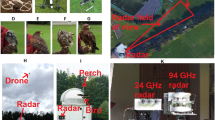Abstract
Unmanned Aerial Vehicles, also known as drones, are being utilized increasingly in numerous fields due to their multiple applications. To ensure safe operations, these drones must be detected successfully in free space and raining scenarios. However, the current radars that identify larger targets, such as aeroplanes, may not be helpful as these drones are relatively small. To successfully identify a drone, the radar designer must carefully design the system using the attributes of the target to be picked up successfully by the radar. The characteristics of an X-band radar would differ significantly from those of an L-band radar. We examine the Swerling models and their application to drones to simulate the drones’ radar cross-section fluctuation using the Swerling-I model. The radar range equation uses the signal-to-noise ratio calculated from the Receiver Operating Characteristic curve to detect a drone using L-band and X-band radars in free space and rain scenarios. The analysis reveals that X-band radar experiences greater attenuation in rainy conditions than L-band radar, even though it possesses superior resolution capabilities at the same transmitted power. Nevertheless, the selection between these two radar types hinges on the particular detection scenario and prevailing environmental conditions.
Access this chapter
Tax calculation will be finalised at checkout
Purchases are for personal use only
Similar content being viewed by others
References
Banu TP, Borlea GF, Banu C (2016) The use of drones in forestry. J Environ Sci Eng B 5(11):557–562
Michels M, von Hobe CF, Weller von Ahlefeld PJ, Musshoff O (2021) The adoption of drones in German agriculture: a structural equation model. Precis Agric 22(6):1728–1748
Coluccia A, Parisi G, Fascista A (2020) Detection and classification of multirotor drones in radar sensor networks: a review. Sensors 20(15):4172
Nguyen P, Ravindranatha M, Nguyen A, Han R, Vu T (2016) Investigating cost-effective rf-based detection of drones. In: Proceedings of the 2nd workshop on micro aerial vehicle networks, systems, and applications for civilian use, pp 17–22
Uzair M, Brinkworth RSA, Finn A (2021) A bio-inspired spatiotemporal contrast operator for small and low-heat-signature target detection in infrared imagery. Neural Comput Appl 33:7311–7324
Balanis CA (2015) Antenna theory: analysis and design. Wiley, London
Diao PS, Alves T, Poussot B, Azarian S (2022) A review of radar detection fundamentals. IEEE Aerosp Electron Syst Mag 1:1
Ritchie M, Fioranelli F, Griffiths H, Torvik B (2015) Micro-drone RCS analysis. In: 2015 IEEE radar conference. IEEE, pp 452–456
Guay R, Drolet G, Bray JR (2017) Measurement and modelling of the dynamic radar cross-section of an unmanned aerial vehicle. IET Radar Sonar Navig 11(7):1155–1160
Sedivy P, Nemec O (2021) Drone RCS statistical behaviour. In: Proceedings of the MSG-SET-183 Specialists’ meeting on “Drone Detectability: Modelling the Relevant Signature”. North Atlantic Treaty Organization (NATO), Held Virtually (via WebEx), pp 1–4
Richards MA (2014) Fundamentals of radar signal processing. McGraw-Hill Education, New York
Acknowledgements
The authors would like to thank Ministry of Higher Education Malaysia for Fundamental Research Grant Scheme with Project Code FRGS/1/2022/TK07/USM/02/14 for permitting them to carry out this research.
Author information
Authors and Affiliations
Corresponding author
Editor information
Editors and Affiliations
Rights and permissions
Copyright information
© 2024 The Author(s), under exclusive license to Springer Nature Singapore Pte Ltd.
About this paper
Cite this paper
Liaquat, S., Mahyuddin, N.M., Naqvi, I.H. (2024). Drone Detection Using Swerling-I Model with L-Band/X-Band Radar in Free Space and Raining Scenario. In: Ahmad, N.S., Mohamad-Saleh, J., Teh, J. (eds) Proceedings of the 12th International Conference on Robotics, Vision, Signal Processing and Power Applications. RoViSP 2021. Lecture Notes in Electrical Engineering, vol 1123. Springer, Singapore. https://doi.org/10.1007/978-981-99-9005-4_53
Download citation
DOI: https://doi.org/10.1007/978-981-99-9005-4_53
Published:
Publisher Name: Springer, Singapore
Print ISBN: 978-981-99-9004-7
Online ISBN: 978-981-99-9005-4
eBook Packages: Intelligent Technologies and RoboticsIntelligent Technologies and Robotics (R0)




